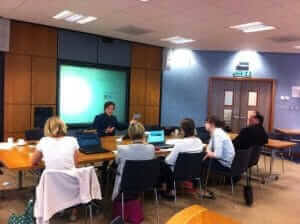
Digital Participatory Budgeting: Opportunities and challenges
Digital PB Workshop at the International PB conference on 20th October 2016: Reflections from Susan Ritchie, Acting UK PB Network Chair and Director of MutualGain

I have just left the exceptionally good international PB conference held in Edinburgh by the Scottish Government, in partnership with the PB Partners and the SCDC. Well done to all for a fab two days!
This blog captures some of the dialogue that took place in a workshop which was exploring the inclusion of digital PB in authorities ‘offer’. The workshop was led by Alistair Stoddart of DEMSOC, who has been providing support to local authorities in Scotland on PB.
Digital PB as a way of meeting the PB Principle of Inclusion
The first thing I want to say is that PB has evolved out of a commitment to social justice. One of the principles that the PB Unit developed, and the UK PB Network continue to uphold, is Inclusion: conducting a digital PB exercise can help to include those that can’t get involved in person, so don’t always view onlione as exclusionary: it can include some of the most vulnerable in our societies. It should not, however, be used to replace in person dialogue and approaches – what is needed is a nice blend of the two to ensure that it is as inclusive as is possible.
Getting the balance right between access and security
One of the big issues that people get preoccupied with when discussing digital PB is the balance between access and security. How do we verify eligible participation in the process? Internationally this is easy as they have ID cards, and are happy to use ID cards to participate. That’s unlikely be the case in Britain – we could use council tax bills, passports, bank ID, Young Scot cards etc, but they may also prove to be barriers to participation in a n era of distrust in political decision making. We also need to consider the implications of those verification criteria on the principle of inclusion, and our commitment to social justice. For instance, in some ‘in person’ PB examples we find people as young as 8 able to participate, people with no fixed abode able to vote, and citizens who do not have British citizenship but who have lived in an area for a long time, participating. That is inclusive and can be the start of peoples’ re engagement in the local decision making process.
We rarely ask people to verify their address at in person PB and if we do, we don’t really have any stringent controls in place to check and verify the ID they use. We felt that when starting out on a journey of PB we should be as flexible as possible – trust in people rather than assume they are all fraudsters, and as the pot gets bigger, the system gets refined, and increased numbers of disengaged people, re engage, we can demonstrate the other principle of transparency, and maybe then, make the voting process for robust? This will be important when we are discussing large million pound allocations to local areas, and adopting PB as a way of deciding how mainstream budgets are spent.
Skewed Voting
When we train and support people to deliver in person PB we get lots of questions about residents who may bring all their friends along and make the process unfair but just voting for their own project and not others. There are voting systems that help mitigate that off line, and the same systems can be used online.
What we heard at the workshop is ranking from 1 – 5 isn’t always the best way to encourage cohesion: PB is about more than voting and we should get creative with our voting processes to move away from the competitive vote, to collaborative decision making. After all, we don’t have a perfect voting system in a current national democratic decision-making, do we?
Investing in our staff and community
We heard how important it was to invest in training and support for staff and residents to engage in this process. You can only improve the quality of dialogue by engaging face to face and ensuring staff and residents are supported in understanding the principles of PB, and you can improve the scale of PB by taking that learning and applying at scale – on and off line. The stronger we get at this, the stronger PB will become.
Resources/Citizens/Goals
So, the upshot of the conversation was that your process will be strengthened or hindered depending on:
- How clear you are about your goals (quantity or quality? Voting or building a civic core?)
- What resources you have (people, money, assets)
- Who you want to engage (inclusive or exclusive?)
What we must do is capture our learning so that others can build on our successes and mistakes, and when it comes to on or off line, we should be doing a blend!
- View the DemSoc digital tools in Scotland webpage
- Download DemSoc’s paper of digital PB tools
